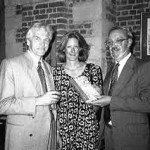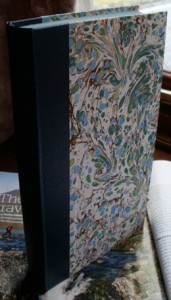Peter Lovesey, The Last Detective
£60.00
£50.00
Peter Lovesey has been writing high quality crime whodunnits for 40 years. His early work comprised the Victorian investigations of Sergeant Cribb, a most engaging series, followed by the Bertie Prince of Wales Edwardian mysteries and stand alone thrillers; more recently his has concentrated on the contemporary Peter Diamond detective series. This is the first Peter Diamond. It is a fitting tribute to an outstanding British crime talent.
In Stock: 3 available


Peter Lovesey, Hilary Hale and Michael Johnson at the book launch in London.
Peter Lovesey began his crime writing career with Wobble to Death (1970). This and his other early books (Waxwork is my favourite) established his reputation as one of Britain’s best practitioners of the intricately plotted crime novel and short story. His early books concerned the investigations of Sergeant Cribb and Thackeray in Victorian settings. These books were turned into a successful Granada television series with Alan Dobbie playing Cribb. He then moved to standalone historical mysteries such as The False Inspector Dew (1982) – a notable winner of the CWA’s Gold Dagger Award. Lovesey also wrote the engaging and light-hearted Bertie series.
This is his first contemporary detective story (now a major series with canny policeman Peter Diamond). It is notable that lengthy tributes are paid to The Last Detective (1991) in both the Symons critique Bloody Murder (1992 revised edition) “a wonderfully intricate puzzle” and in Martin Breese’s Guide to First Editions which emphasises that the old fashioned methods of detection can still out shine modern techniques. He was admired by contemporaries such as H R F Keating, Colin Dexter and Julian Symons. Peter Lovesey wrote an interesting introduction to this volume that reflects on his career and his thoughts on the creation of the Peter Diamond series. The Last Detective deservedly received the Anthony Award at the Boucheron and is an excellent gift for a crime buff. Few copies in stock.

 J L Burke, House of the Rising Sun
J L Burke, House of the Rising Sun
 Dick Francis, Second Wind
Dick Francis, Second Wind

Rating by E-notes.com on April 9, 2012 :
“THE LAST DETECTIVE is a classic novel of detection. The protagonist, Peter Diamond, is a detective who must solve the murder of an unidentified young woman. The victim is identified as former television star Geraldine Jackman, who was married to a professor of English at Bath University. Diamond’s suspicions immediately fall upon the husband, Greg, since their marriage was marred by her fits of rage. He interrogates Greg to find some flaw in his story. Diamond does not hold with new methods which use computers and scientific instruments. The second in command, John Wigfull, wishes to use the new methods to solve the case, so there is a conflict. Later, Diamond discovers that Greg was out of the country and has an alibi.
Suspicion then turns to Dana Didrikson, a friend of Greg, whom Geraldine saw as a rival. While attempting to bring Dana in for questioning, Diamond is attacked by Dana’s young son, Matthew, who later claims that Diamond injured him. When a supervisor confronts Diamond on this charge, the second such charge against him, Diamond resigns in anger. The way is clear for Wigfull to use his scientific methods to prosecute Dana.
Diamond is now a civilian, but he persists in attempting to solve the crime. His old methods prevent a miscarriage of justice, and he uncovers the true murderer in the last scene. The revelation is startling and is worthy of the best detective fiction.
THE LAST DETECTIVE is a compelling read, and it gives us real insight into the characters of Greg and Dana. However, Lovesey’s greatest creation is Peter Diamond”. from E-notes.com
Rating by Peter Lovesey on May 21, 2012 :
Extract from the Introduction by Peter Lovesey
… The adventures of my Victorian policeman were amusing to write and helpful in my apprenticeship. Anyone those books will have seen that I used the Victorian settings and the character Cribb to try out various techniques in story-telling. One followed the route of Jerome K. Jerome’s Three Men in a Boat. Another was a Victorian version of a James Bond thriller. The last of the series, Waxwork, was an attempt at a serious theme, with a real hangman waiting to do his work. I had in mind several of the most famous nineteenth century cases of women accused of poisoning. … But I was wary of setting a crime novel in the present. For one thing, murder was no longer the sensational crime it had been in the last century, or even in the nineteen-forties, when I was growing up. The abolition of the death penalty seems to have robbed the capital crime of some of its macabre fascination. … I ventured forward in time to the 1920s and wrote a book based on the idea that a real murderer, Dr Crippen, might have been successful if he had planned his crime in a slightly different way. The False Inspector Dew was well received and appeared to confirm me as a writer of ‘period’ – if not Victorian – crime novels. That reputation hardened with Keystone (set in 1916). Rough Cider was set in the 1960s, but harked back to World War II. And On the Edge was about two women who set out to murder their husbands in 1946. The latest is The Last Detective,… its rather good to be here at last, sneaking through behind the ample form of the Last Detective himself, Peter Diamond. With a blend of Bertie’s arrogance and Cribb’s distrust of new methods of policing, Diamond is determined to keep the forensic scientists, the ‘men in white coats’, on the fringes of the investigation. Secretly he dreams of writing his memoirs, to be entitled Diamond of the Yard – in the fine tradition of detectives who wore trilby hats and fawn-coloured raincoats and had nicknames like ‘Nipper’.